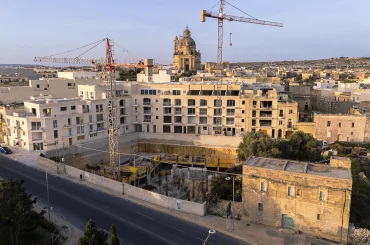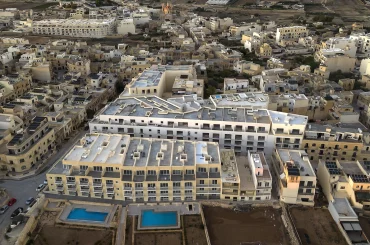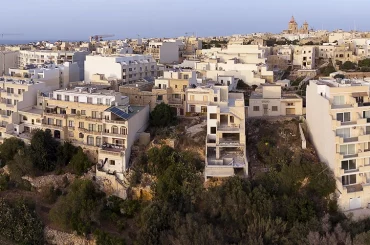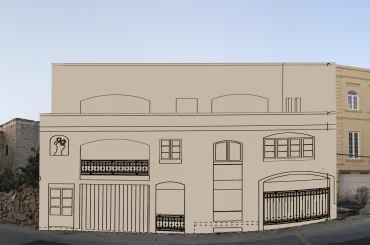Large-diameter PVC pipes have been embedded into a stretch of rubble wall built by the Sannat local council using EU rural funds intended to enhance biodiversity and restore habitats in rural areas, an investigation by this website has found.
The pipes are in breach of laws that protect rubble walls, and a spokesperson for the Planning Authority said that these “need to be removed.”
The stretch built by the council is part of a longer stretch of rebuilt rubble wall that runs from the edge of the development zone to the cliff’s edge near Ta Cenc, a sensitive area protected as a Natura 2000 site and doubly as a Special Area of Conservation.
The council built a 120-metre-stretch of rubble wall up to the boundary of the protected area. The wall runs between a dirt road and land whose ownership is registered in the name of Excel Investments Limited at the Land Registry.

Excel – owned by Joseph Portelli, the Agius brothers (Ta Dirjanu), and Daniel Refalo – has been developing one of Gozo’s densest cluster of flats on the part of the land that falls within development zones. Various works have also been carried out – or are planned – on its strip of land that stretches beyond the development lines to the cliff’s edge.
Embedded at regular intervals, the PVC pipes start from a part of the wall built by the council, and continue throughout the rest of the rebuilt wall to the cliff’s edge. The purpose of these pipes is not known.
This website is publishing video footage – featured on top of the page above – after the mayor of Sannat’s local council, Philip Vella, said that there are no PVC pipes in the part of the wall built by the council. The council’s architect, Edward Scerri, also said that “no PVC pipework was included within the stretch of rubble wall restored by the local council.”
Vella said: “The council did not put plastic pipes in the part of the wall built by the council. We can go on site, and if you see any pipes in the wall, you can write an article about that.”
Told of photographic and video evidence, Vella then suggested that perhaps these had been put in the wall after the council had built the wall.
The PVC pipes have been embedded deeply in the wall, which suggests that they were placed during the construction, not inserted afterwards. Some of them are covered by stones. Others protruded above the wall at one point, but these were then cut down to the wall’s level following an article published on this website on 6 February 2022.
Pipework also emerges at the base of the wall built by the council, where a wide opening was used by trucks to deposit rubble in the fields.

The mayor’s declaration
The local council’s building of the rubble wall emerged after Vella submitted a declaration in relation to a planning application for four stables. In the declaration – made after the Planning Commission queried whether the rubble wall along the field’s perimeter needed to be sanctioned as part of the stables’ application – Vella declared that the council had built a 120-metre stretch of rubble wall that ends just beyond the point where the stables are proposed.
The applicant or his architect may now argue that the applicant is not responsible for any potential requirement to sanction the wall, a point queried by the Planning Commission.
The proposed stables sit on land registered under Excel at the Land Registry. The Planning Commission has asked the project architect, Alex Bigeni, to clarify whether the applicant, Marlon Mercieca, owns the land.
The mayor Philip Vella said that the council had initially applied for EU rural funds to build the entire stretch (of 350 metres) until the cliff’s edge but the Managing Authority, which administers EU rural funds, limited funding to land outside Natura 2000 site and hence the council only built the 120-metre stretch up to the Natura 2000 boundary. He said he does not know who built the rest of the wall to the cliff’s edge beyond the council’s stretch.
Part of the council’s wall runs along the grounds at the back of one of the developers’ blocks of flats. These grounds stretch back from the swimming pool and – on promotional material – feature a lawned garden, snack bars or barbecue areas, sitting area, and a treehouse.

Although the council applied for EU funding before Excel applied for development permits, work on the block of flats had already started when the council’s wall was built. At the time of the actual construction of the rubble wall, the flats had been on sale for a year, the promotional material published many months before, the flats were already a widely-reported controversy, and work on site had started.

The rules on EU rural funds prohibit grants for works that are “directly or indirectly linked to private dwellings and other residential/accommodation premises.”
Asked about this, the mayor Philip Vella said: “We built the wall along the path, it has nothing to do with the private property whose grounds is one-storey below the level of the path.”
The application for stables was put in after the rubble walls had been built. The Environment and Resources Authority has objected to the plans, writing that the stables and “ancillary facilities will result in the take-up of agricultural land, the proliferation of built structures and loss of rural character of the site. This is of concern from an environmental point of view, especially when noting site context, directly adjacent to a protected site.”
EU grants for habitat restoration
The council got a grant to build the wall under so-called measure 4.4. These are defined as “non-productive investments” because the point is not to increase the value or monetary return of the “beneficiary’s holding [farm], but have a positive environmental impact.” The “particular focus” of such grants is “the restoration of habitats and landscapes, soil conservation and water management.”
Examples of works eligible for rural grants listed in funding manuals were “planting of trees and removal of invasive/alien species; the establishment, repair and restoration of field boundaries such as terraced rubble walls, field vegetation hedges and borders; and related investments and works that are necessary for the restoration and management of habitats and areas of ecological importance, for soil and water conservation and for the reduction of greenhouse gas emissions.”
In this case, the superficial weathering of the stones and deeply-embedded PVC pipes suggests that parts, if not all, of the council’s wall was rebuilt from the ground up largely using new stones. Planning legislation, designed to protect rubble walls as ecological habitat, specifies that a planning permit is needed for “total demolition and reconstruction of existing” walls. The council did not apply for a planning permit as it deemed the works as restoration, which does not require a permit.
Asked whether the council’s rubble wall was in conformity with the rules and aims of EU rural funds – or whether it was merely infrastructural works (not restoration of habitat) – the mayor Philip Vella said: “Of course we improved the environment [with the new wall] if you compare it with the wall that existed before.”
He added that the Managing Authority, which administers rural funds, had “audited” the works.
This website has written to the Managing Authority seeking comment.




